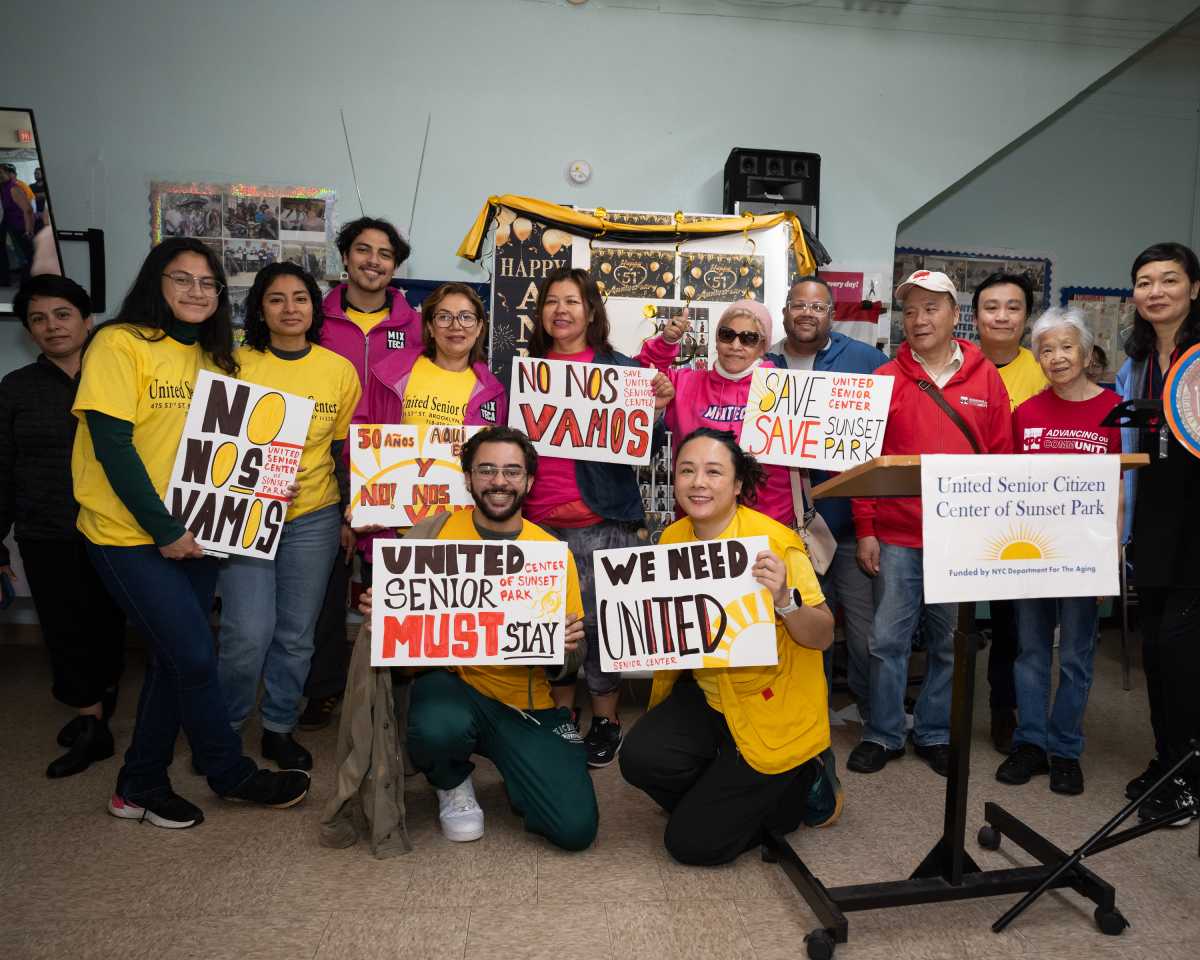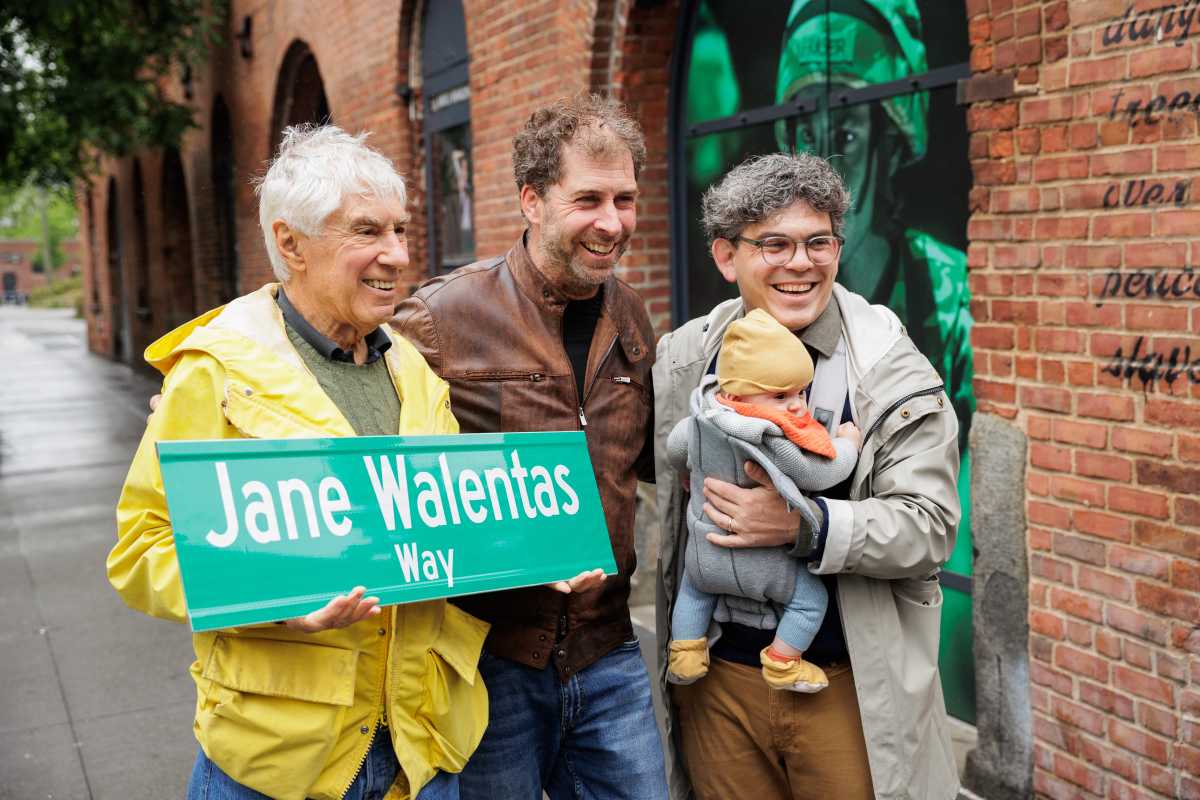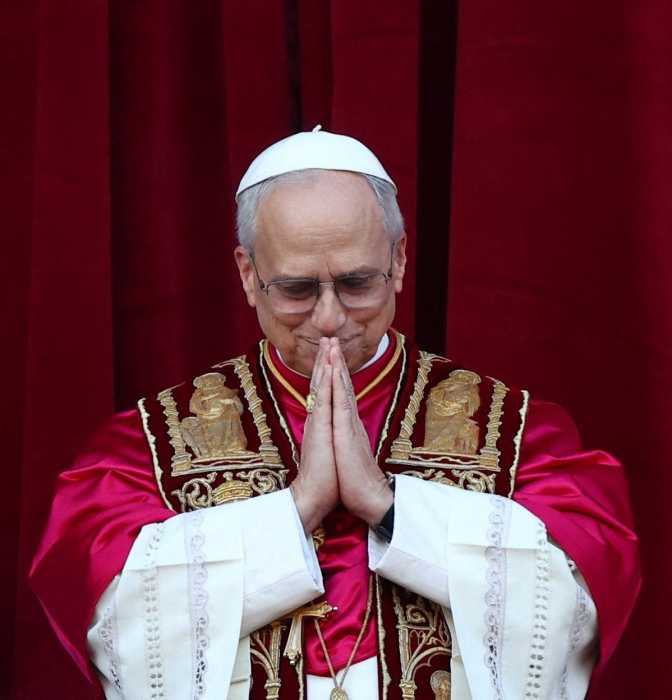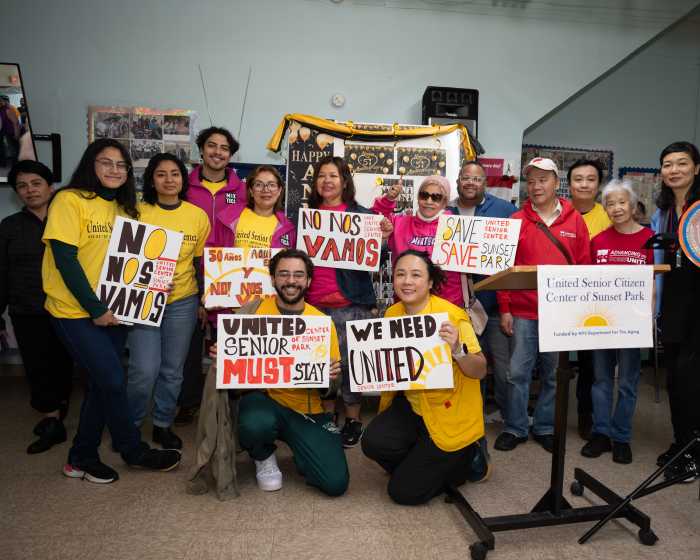
BY TERESE LOEB KREUZER | There’s no need to ask directions to the Bialystoker Center & Home for the Aged at 228 East Broadway. The Art Deco building’s distinctive geometries, executed in warm orange brick, are visible from blocks away. But with the Lower East Side becoming gentrified and real estate increasingly expensive, the Bialystoker nursing home may not be there much longer unless the Landmarks Preservation Commission intervenes.
Built during the Depression by poor, immigrant Jews from Bialystok, Poland, the 10-story structure sheltered the aged and infirm of the Lower East Side for 80 years. On opening day — June 21, 1931 — thousands of people gathered on East Broadway to celebrate, and there were congratulatory telegrams from New York Governor Franklin D. Roosevelt and other elected officials.
The building closed on Nov. 1, 2011.
Now the entrance is shrouded in scaffolding and the glass on the locked door reflects the empty lot across East Broadway where the Young Israel buildings used to be before they were sold to a developer who knocked them down and then ran out of money. In the nursing home’s once-pretty garden, rotting fruit from a peach tree lies on the ground. A sign on a piece of paper by the front door says, “The Bialystoker Center is officially closed. There are no longer any synagogue services being held here.” The note ends with the words, “Goodby to one and all.”
Since October 2011, a battle has raged between the nursing home’s board of directors — who would like to sell the property to a developer for demolition and conversion of the site to luxury apartments — and a group of individuals and community organizations that would like to save the building.
The building’s advocates, organized as the Friends of the Bialystoker Home, have flooded the Landmarks Preservation Commission with letters, postcards and petition signatures. As the first step to landmarking, they have asked that the building be placed on the L.P.C. calendar for a public hearing on its merits. In April, Community Board 3 endorsed landmarking the building. Organizations such as the Tenement Museum, the Art Deco Society of New York and the Two Bridges Neighborhood Council are also on board.
On July 6, City Councilmember Margaret Chin entered the fray by writing a letter to Landmarks on the building’s behalf. She said that the building has architectural and historical significance for the Lower East Side community.
“The Bialystoker Home is part of the fabric of this neighborhood and I could not allow it to be sacrificed for monolithic luxury residential development,” she wrote.
As of Aug. 14, Chin’s office had not received a reply from the L.P.C., but Kelly Magee, a spokesperson for the councilmember, did not find this worrisome.
“We have discussed this project with them extensively and do not anticipate any problems,” Magee said.
Finally, on Aug. 16, there was some news. In response to an inquiry from The Villager, an L.P.C. spokesperson e-mailed to say, “The Commission staff have determined the building is eligible for landmark consideration, and is working with the owners and elected officials to discuss next steps.”
Mitchell Grubler, one of the founders of the Friends of the Bialystoker Home, said he found this response encouraging.
“This means that the building qualifies under L.P.C. standards to be a landmark,” he said. “That’s something that I have not heard from them before.”
However, as of Aug. 21, the building had still not been placed on the commission’s calendar, which is the first step in the landmarking process and would buy the Bialystoker home a 40-day reprieve during which it could not be sold or altered in any way.
“I’m glad they’re working on it, but it doesn’t really get us to action,” said Linda Jones, a founder of the Friends of the Bialystoker Home and a member of C.B. 3’s Landmarks Committee. “I hope their statement means that they’re getting close to calendaring.”
She believes that the Landmarks Preservation Commission intends to do it, but, she said, “It is really a matter of doing it before something happens to the building. We’ve had a lot of experience on the Lower East Side of owners doing damage to buildings to make them less eligible for landmarking. We don’t want to see that happen.”
Jones lives in the Seward Park co-op behind the Bialystoker nursing home, which she can see from her window.
“We have a lot of people watching that building,” she said. “If we saw workers doing damage to it, we would call the police.”
The Bialystoker nursing home is millions of dollars in debt. The owner, Bialystoker Center and Bikur Cholim, Inc., owes up to $14 million to New York City and New York State and to the union, 1199/SEIU United Healthcare Workers East, whose members worked in the home.
Bialystoker’s six-member board of directors, headed by Ira Meister, who owns a real estate management firm, says that it is necessary to sell the historic building to the highest bidder in order to pay off the debt.
According to Magee, the board received between 10 and 15 proposals for the property and selected the Aegis Group, which would pay $17 million for the purchase, tear down the existing building and erect luxury condominiums.
But, Magee said, “Aegis has issues with landmarking” and would not buy the property if it were landmarked. Aegis claims that the nursing home’s floor plates would not be suitable for residential development and that the building isn’t structurally sound, Magee said.
She added that 1199/SEIU “has come to some agreement with Bialystoker to cover pension, job placement, health benefits and back pay for their workers. The workers are taken care of,” which, she said, was a concern for Chin.
When the building is sold, the New York State Attorney General’s Office would have to sign off on the sale because the current owner is a nonprofit organization. The A.G.’s Office is also said to be looking into allegations of financial improprieties on the part of board president Meister. In 2010, Meister bought a three-story building from the nursing home that stands on an adjoining lot. He paid $1.5 million in cash for the building, in a no-bid, closed deal.
Meister said that he did the transaction to shore up the Bialystoker home’s finances. Others have pointed out that he profited from buying the building at a price well below market value. The Attorney General’s Office will not comment on whether it is investigating this deal and, if so, where the investigation stands.
A mural painted in 1973 extolling the Lower East Side Jewish community and the ILGWU, which built the nearby Seward Park co-op, ornaments the side of the building that Meister bought. The mural says, “Our strength is our heritage.”
In addition to appreciation for the Bialystoker building’s architecture, the loss of much of that heritage is what fuels the Friends of the Bialystoker Home’s fight.
“I’m tired of big, high-rise buildings,” said Marcia Iconompolous, who is part of the group. “I understand the profit motive. I understand that real estate on the Lower East Side is cheaper relative to other areas, but we’re losing so much of what this neighborhood was about.”
Across from the Bialystoker home, there are still some small Jewish shuls and community service organizations in run-down, 19th-century houses. But on the ground floor of the six-story walk-up on the corner of East Broadway and Clinton St. there are now cute stores selling Stumptown coffee and gourmet cheeses.
Down the street, at 175 East Broadway, the landmarked building that once housed the Jewish Daily Forward, was converted into condos in 1999. Ironically, considering the portrait busts of Karl Marx, Friedrich Engels and other Socialists on the front of the building, apartments there now sell for millions of dollars and rent for as much as $15,000 a month.
“The Bialystoker home was constructed by working people who, in the Depression, raised $40,000 to construct this building to take care of the elderly poor of the neighborhood,” said Joyce Mendelsohn, one of the founders of the Friends of the Bialystoker Home. “The building stands as a reflection of the culture of caring, which is part of the legacy of the Lower East Side.”
For that reason alone, were there no other, she believes that the Bialystoker home must be saved.

































